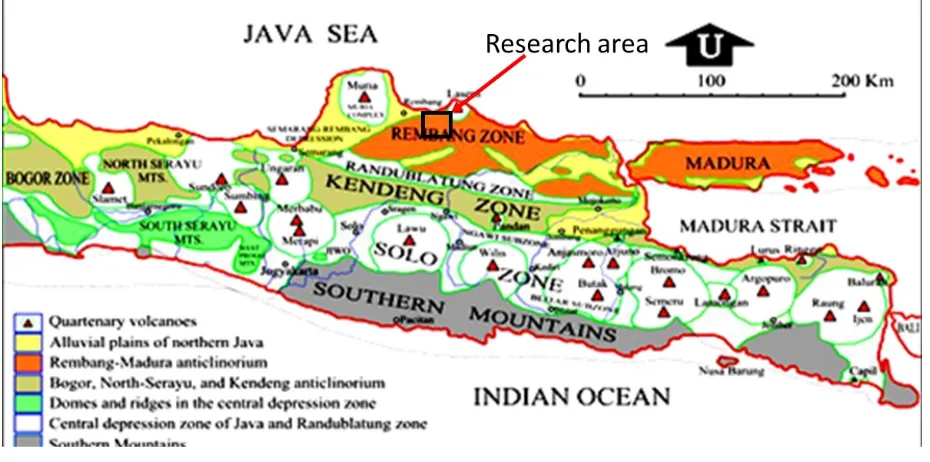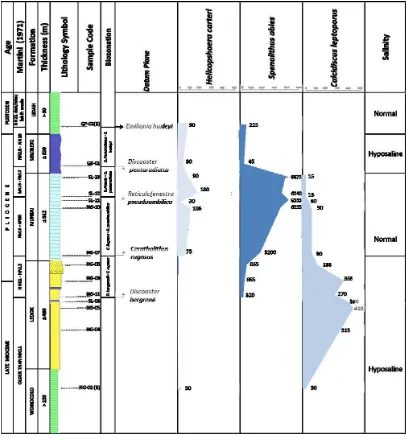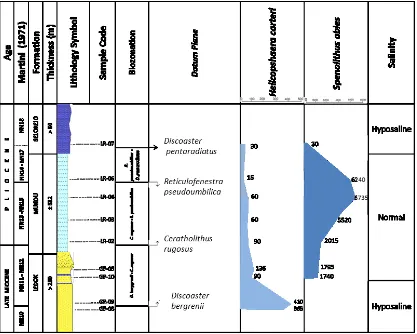©2014 Pusat Penelitian Geoteknologi Lembaga Ilmu Pengetahuan Indonesia
1
PALEOSALINITY CONDITIONS ON LATE MIOCENE
–
PLEISTOCENE IN THE NORTH EAST JAVA BASIN,
INDONESIA BASED ON NANNOPLANKTON POPULATION
CHANGES
Kondisi Paelosalinitas pada Miosen Akhir
–
Pleistosen di Cekungan
Jawa Timur Utara, Indonesia, Berdasarkan Perubahan Populasi
Nanoplankton
Wahyu Dwijo Santoso
1, Halmi Insani
1, and Rubiyanto Kapid
11
Study Program of Geology, Faculty of Earth Sciences and Technology, Institut Teknologi Bandung (ITB)
ABSTRACT Quantitative biostratigraphy analysis by observing Sphenolithus abies and
Helicosphaera carteri could predict paleosalinity
changes at a sedimentary basin diachronically. Hyposaline conditions can be investigated from the abundance changes of Helicosphaera carteri
and Calcidiscus leptoporus counts. Along this
line, the increasing number of Sphenolithus abies demonstrates particular states of normal saline. Paleosalinity changes in the North East Java Basin, from Late Miocene to Pleistocene were identified from the top of Wonocolo Formation to bottom of Ledok Formation. Paleosalinity along this episode was interpreted as hyposaline condition. While at the top of Ledok Formation to Mundu Formation, paleosalinity had changed
to normal saline. Furthermore, environment conditions return to hyposaline when Selorejo Formation sediment was deposited. And during the deposition of Lidah Formation, deposition environment had returned to the normal saline.
Keywords: paleosalinity, quantitative biostratigraphy, Helicosphaera carteri, Sphenolithus abies
ABSTRAK Analisis biostratigrafi kuantitatif
dengan mengamati keberadaan spesies
Sphenolithus abies dan Helicosphaera carteri dapat digunakan untuk mengungkap perubahan
salinitas purba pada suatu cekungan
pengendapan. Kondisi air laut yang hyposaline dapat diketahui dari perkembangan spesies Helicosphaera carteri yang berlimpah.
Sebaliknya, peningkatan jumlah Sphenolithus
abies akan menunjukkan bahwa lingkungan berada pada kondisi salinitas normal. Dengan mempergunakan asumsi yang sama, maka perubahan salinitas di daerah penelitian yang termasuk ke dalam Cekungan Jawa Timur Utara, pada Kala Miosen Akhir hingga Plistosen, dapat
diinterpretasikan sebagai berikut. Formasi
Wonocolo bagian atas hingga Formasi Ledok bagian bawah, air lautnya dinterpretasikan memiliki kondisi hyposaline. Sedangkan pada Formasi Ledok bagian atas hingga Formasi Mundu, lingkungan berubah menjadi kondisi
_______________________________
2
salinitas normal. Selanjutnya, kondisi lingkungan berubah menjadi hyposaline kembali ketika diendapkan Formasi Selorejo. Sedangkan pada saat pengendapan Formasi Lidah, lingkungan berubah dan kembali pada kondisi salinitas normal.
Kata Kunci: salinitas purba, biostratigrafi kuantitatif, Helicosphaera carteri, Sphenolithus abies
INTRODUCTION
An assumption that the changes in the environment will always be accompanied by changes in the organism has been widely accepted. Therefore by looking at the changes in the number of organisms living in an environment, we can also learn the changes of the environment. Melinte (2004) and Bour et al ., (2007) discussed the nannoplankton as indicators for environmental change. Thereafter, Wade and Brown (2006) also pointed out that the nannoplankton species can be used as indicators of environmental changes, particularly salinity, in the area of Cyprus. They discussed the existence of the species Sphenolithus abies and
Helicosphaera carteri and their relationship with
the water salinity conditions, where both species were found. The results of Melinte’s study (2004) suggested that Calcidiscus leptoporus lives in
hyposaline conditions. While Wade and Brown (2006) concluded that in the Polemi Basin, Cyprus, Helicosphaera carteri is abundant in hyposaline condition. Therefore, an increasing number of environmental Sphenolithus abies manifests normal saline condition. Considering those previous studies, we applied the methods used by Melinte (2004) and Wade and Brown (2006) to investigate paleosalinity condition in North East Java Basin.
Regional Geology
The study area was the North East Java Basin, in the area of Gunung Panti, Pati District, Central Java Province (Figure 1) at coordinates of 06º 52' 30"- 06º 54'09" Latitude and 111º 03' 00"- 111° 05'30" E Longitude. North East Java Basin was selected because Plio – Pleistocene sediments in this basin was deposited in marine environment. Paleosalinity changes can be traced from marine deposits, which its deposition environment was suitable for nannoplankton’s life.
Based on the Physiographic Map of East Java, Gunung Panti area belongs to the Rembang Zone (Figure 1). According to previous regional mapping by Kadar & Sudijono (1993), formations exposed in this area were Wonocolo, Ledok, Mundu, Selorejo and Lidah Formation (Figure 2). Wonocolo Formation consists of claystone intercalated by limestones. Ledok
3 Formation is characterized by coarse sandstone
with limestone intercalation. Mundu Formation is featured by marls with limestone intercalated. Selorejo
Member signifies grainstone limestone with mollusc fragments (de Genevraye and Samuel, 1972; Insani, 2011). Based on the more recent study, the name of Selorejo Member changed to
4
Selorejo Formation (Pringgoprawiro, 1983; Sribudiyani et al., 2003). The youngest formation of Lidah Formation, displays sort of bluish massive mudstone.
METHODS
In the North East Java Basin, measuring section performed at three traverses, namely Sungai Kedunglawah Traverse, Sungai Tambar – Sungai Nggaber Traverse, and Sungai Kedungkembang Traverse (Figure 3). Samples collected were from of Upper Miocene to Pliocene. Nine samples were gathered from Sungai Kedunglawah Traverse, 14 samples were taken from Sungai Tambar – Sungai Nggaber Traverse, while 9 other samples were taken from Sungai Kedungkembang Traverse.
Nannoplankton analysis observations had been accomplished by the commonly-used field of view (FOV) method. Standard-sized cover glass
(120 x 250 μm). In one observation of FOV, the
number of each species of nannoplankton counted 15 times at different places and then multiplied by eight. The rest of the observations were made to find some species markers that might be found in the sample.
Several fossil indicators used in this research were Sphenolithus abies, Helicosphaera carteri
and Calcidiscus leptoporus Sphenolithus abies
(Figure 4a), which have similar environment with
the Discoaster genus. Generally, Sphenolithus
and Discoaster live coexistence in oligotrophic
environments, warm, open ocean conditions and indicate the environment with normal salinity levels (Wade and Brown, 2006).
The abundant of genus Helicosphaera signifies shallow marine environment, which is the zone of upwelling, eutrophic environment.
Helicosphaera carteri (Figure 4b) indicates
hyposaline environmental conditions, eutrophic, and a lot of the shallow marine areas (Wade and Brown, 2006). From the samples taken from the Black Sea, Helicopshaera carteri is a species capable of living in salinity under normal conditions (Melinte, 2004). Calcidiscus
leptoporus (Figure 4c) developed in areas with
below-normal salinity conditions. In samples
taken from the Black Sea, Calcidiscus
leptoporus is a species also capable of living in
salinity under normal conditions (Melinte, 2004).
RESULT AND DISCUSSION
Sungai Kedunglawah Traverse
Comparison of the development of species
Helicosphaera carteri and Sphenolithus abies at
Sungai Kedunglawah Traverse can be observed in Figure 5. On NG-26 samples, which obtained at Wonocolo Formation, there is an appearance
of Helicosphaera carteri, but not Sphenolithus
abies. This predicament indicates that on the top
of Wonocolo Formation, the environment is in hyposaline condition. This is caused by the shallowing environment, where Bulu Formation gradually had become Wonocolo Formation.
The sample of KD - 09, KD - 07, and KD - 06 that were gathered from Upper Ledok Formation has a trend of increasing numbers of Sphenolithus
abies and loss of Helicosphaera carteri. It shows
that when Ledok Formation was deposited, the environment is in normal saline condition.
KB-05 samples were taken on Mundu Formation with the peak of abundance of Sphenolithus abies that reaches 4815 counts and the peak of the abundance of Helicosphaera carteri that reaches 105 counts. The higher number of Sphenolithus
abiesis than Helicosphaera carteri shows that
when the Mundu Formation was deposited, the environment was more suitable for the live of
Sphenolithus abies. It indicates that when the
Mundu Formation deposit was accumulated, the environment was in normal saline.
Sungai Tambar - Nggaber Traverse
Comparison of the development of species
Helicosphaera carteri and Sphenolithus abies on
5
F
ig
u
re
3
:
T
ra
v
er
se
a
n
d
S
am
p
li
n
g
Ma
6
Figure 4. Fossil indicator.
a. Sphenolithus abies b. Helicosphaera carteri c. Calcidiscus leptoporus
(Picture was taken from Young et al., 2011)
Figure 5. Column of Poppulation Changes Sphenolithus abies and
Helicosphaera carteri in Sungai Kedunglawah Traverse.
7 From sample of NG-02 (B) that was taken on
Wonocolo Formation, there is an appearance of
Helicosphaera carteri, but not Sphenolithus
abies. It implies that the top of Wonocolo
Formation has environment of hyposaline condition. It is caused by a gradual shallowing environment of Bulu Formation that became Wonocolo Formation.
Sample NG - 04, NG - 05, and SL - 06 were taken from the bottom of Ledok Formation. There is no Sphenolithus abies and
Helicosphaera carteri found in these samples.
However, there is a trend of an increasing
number of Calcidiscus leptoporus species. Based on Melinte (2004), Calcidiscus leptoporus lived in hyposaline conditions. NG - 11 NG - 09, and NG - 08 samples were taken from upper of Ledok Formation. There is an increasing trend of
Sphenolithus abies and loss of Helicosphaera
carteri in these last samples. Based on
Calcidiscus leptoporus trend, generally
fluctuative population trend can be observed. This can be occured due to transition of salinity change from hyposaline condition to normal saline condition and it made unstable salinity condition.
Figure 6. Column of Poppulation Changes Sphenolithus abies, Helicosphaera carteri,
8
Sample NG - 07, NG - 10 SL - 11 SL - 12, and SL - 13 were taken from Mundu Formation. There is a trend of an increasing number of
Sphenolithus abies and reached a peak at the top
of the zone Mundu Formation, which reached 6675 counts. The number of species
Helicosphaera carteri showed a fluctuating
trend. Therefore, in Mundu Formation, the species used to interpret salinity conditions is
Calcidiscus leptoporus. The development of the
species displayed a tendency of decreasing
Calcidiscus leptoporus. Based on Melinte (2004),
Calcidiscus leptoporus lives on hyposaline
conditions. This event manifested when the Mundu Formation accumulation was deposited in normal saline environment Sample GK - 01 that was taken from Selorejo Formation has the tendency of decreasing trend in the number of
Sphenolithus abies and Helicosphaera carteri.
Sphenolithus abies falls of 6675 counts in the
sample SL - 13 to 45 counts in GK - 01. In the same sample, Helicosphaera carteri is down
from 90 counts to 30 counts. The declining number of Sphenolithus abie demonstrated that when Selorejo Formation sediment was deposited, the environmental condition was not in suitable for Sphenolithus abies. This indicated that the Selorejo Formation environment was a very shallow area with hyposaline condition.
At the bottom of Lidah Formation, there is an increase in the number of Sphenolithus abies and
Helicosphaera carteri. Sphenolithus abies has
increased from 45 to 225 counts. Helicosphaera
carteri has increased from 30 to 90 counts. This
event signifies that when Lidah Formation was accumulated, the environment is suitable for
Sphenolithus abies, which favourably developed
in conditions of normal saline.
Sungai Kedungkembang Traverse
Comparison of the development of species
Helicosphaera carteri and Sphenolithus abies on
Sungai Kedungkembang Traverse can be
9 observed in Figure 7. Nannoplankton analysis
results on the Sungai Kedungkembang Traverse have the same trend with the results on the Sungai Kedunglawah Traverse and Sungai Tambar – Sungai Nggaber Traverse.
In the GP - 08 and GP 09 samples that were taken from the bottom of the Formation Ledok, there is an appearance of Helicosphaera carteri, but not
Sphenolithus abies. It shows that when the
bottom of Ledok Formation was deposited, the environment was at hyposaline condition. From GP -10 and GP - 05 samples that were taken from the top of the Formation Ledok, the count of
Helicosphaera carteri dropped, while the total of
Sphenolithus abies slightly increased. It shows
that when the upper Ledok Formation sediment was deposited, the environment had normal saline conditions.
In sample LR - 02, LR - 03, LR - 04 and LR - 06 that were taken from Mundu Formation, there is a raising number of Sphenolithus abies, while
Helicosphaera carteri number was down. This
indicates that when Mundu Formation was deposited, the environmental conditions were suitable for the life of Sphenolithus abies in normal saline conditions.
Sample KB - 05 that was taken from Selorejo Formation has drastically low in the Sphenolithus
abies counts. In sample LR - 06, the count
decreased from 6240 to 30. However, a decrease in the number of Sphenolithus abies was followed by an increase of Helicosphaera carteri. This indicates that the Selorejo Formation environment was at a very shallow area with salinity of hyposaline.
The salinity changes were studied based on the analysis of nannoplanktons. Population of
Spenolithus abies would increase in normal
salinity environtment, but population of
Helicosphaera carteri and Calcidiscus
leptoporus would increase in hyposaline
environtment. Salinity changes were presented in the salinity curve (Figure 8). In upper part of Wonocolo Formation, sediment was deposited on hyposaline conditions. Hyposaline environment condition continued to the bottom of Ledok Formation. At the top of the Ledok Formation, environment condition was in transition from hyposaline to normal saline condition. However, based on interpretation from Sungai Kedungkembang Traverse, top of Ledok
Formation was deposited in normal saline condition. Normal saline condition continued to the top of Mundu Formation. Environment condition turned out to be hyposaline when Selorejo Formation was deposited. In the bottom of Lidah Formation, the environment changed and returned to the normal saline condition.
Salinity condition has not related to lithology, but to depositional environtment. For example, claystone could be deposited in hyposaline condition if it was deposited in the delta or lagoon. However, claystone could be deposited in normal saline condition if it was deposited in open marine.
Based on this study, salinity condition can be interpreted from nannoplankton population changes. However, isotopic analysis, such as 18O isotope analysis, must be done for further verification.
CONCLUSION
Population changes of Helicosphaera carteri,
Sphenolithus abies, and Calcidiscus leptoporus
could be used to determine the salinity of environment when the sediment was deposited. An increasing number of Helicosphaera carteri
and Calcidiscus leptoporus would indicate the
condition of hyposaline environment. And an increasing number of Sphenolithus abies would indicate a state of normal saline.
In the North East Java Basin, changes in paleosalinity found from population changes of
Helicosphaera carteri, Calcidiscus leptoporus,
and Sphenolithus abies. At the deposition of
upper part of Wonocolo Formation (NN10), the sediment deposited in hyposaline conditions.
10
11 REFERENCES
Bour, I., Mattioli, E., Pittet., B., 2007. Nannofacies analysis as a tool to resconstruct palaeoenvironmental changes during the Early Toarcian anoxic event. Palaeogeography, Palaeoclimatology, Palaeoecology 249, 58–79.
De Genevraye, P., D., Samuel, L., 1972. Geology of the Kendeng zone (Central and East Java). Proceeding of Indonesian Petroleum Association First Annual Convention.
Insani, H. 2011. Geologi dan Analisis Biostratigrafi Nannoplankton Darah Gunungpanti dan Sekitarnya, Kabupaten Pati, Jawa Tengah. Bachelor Thesis, Institut Teknologi Bandung, Unpublished.
Melinte, C.M., 2004. Calcareous Nannoplankton, A Tool to Assign Enviromental Changes, Geo Eco Marina, Bucharest.
Kadar, D., and Sudijono, 1993. Geological map of Rembang sheet with scale 1:100.000. Bandung Geological Research and Development Center , Bandung.
Pringgoprawiro, H., 1983. Biostratigrafi dan Paleogeografi Cekungan Jawa Timur
Utara Suatu Pendekatan Baru. PhD Dissertation, Geology Department, Institut Teknologi Bandung.
Sribudiyani, I., Muchsin, N., Sapiie, B., Ryacudu, R., Asikin, S., Kunto, T., Harsolumakso, A., Astono, P., Yulianto, I., 2003. The Collision of East Java Microplate and Its Implication for Hydrocarbon Occurence in The East Java Basin, Proceeding Indonesian Petroleum Association 30th Annual Conventin & Exhibition. Soft file: IPA03-G-085.
Van Bemmelen, R.W., 1949. The Geology of Indonesia, Netherland: Martinus Nyhoff, The Haque.
Wade, S.B. and Brown, R.P., 2006. Calcareous Nannofossils in Extreme Environments: The Messinian Salinity Crisis, Polemi Basin, Cyprus. Jurnal of Palaeogeography, Palaeoclimatology. Palaeoecology 233, 271– 286.






